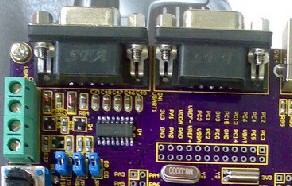在嵌入式產品開發中,我們經常會遇到兩個設備之間的通信、設備與服務器的通信、設備和上位機的通信等,很多時候通信協議都是自定義的,所以這就涉及到自定義協議的解析和組包問題。
比如針對下面的這樣一個協議:
| 幀頭1 | 幀頭2 | 字段1 | 字段2 | 校驗 |
|---|---|---|---|---|
| 固定值:0x55 | 固定值:0xAA | 設備ID | 電壓值 | 前面所有數據異或值 |
| char | char | short | float | char |
| 1字節 | 1字節 | 2字節 | 4字節 | 1字節 |
數據在發送時涉及到一個大小端的概念,大小端是針對多字節數據的傳輸,比如上述協議中字段1,假設兩字節內容為0x0001,先發送0x01后發送0x00,稱為小端模式;先發送0x00后發送0x01,稱為大端模式。
假設字段1內容為0x001,字段2內容為0x40533333(對應為3.3)
假設按照小端方式發送,下面是幀數據:
55 AA 01 00 33 33 53 40 ED
下面來看看如何解析:
若干年前,在第一次面對這種問題時,用的如下傻瓜式的代碼方式實現:
#includeintmain() { unsigned char Rxbuf[9]={0x55,0xAA,0x01,0x00,0x33,0x33,0x53,0x40,0xED}; short DeviceId; floatVoltage; unsigned char check=0; int i; for(i=0;i<8;i++) ????{ ????????check?^=?Rxbuf[i]; ????} ????if(Rxbuf[0]==0x55?&&?Rxbuf[1]==0xAA?&&?Rxbuf[8]==check?) ????{ ????????DeviceId=(Rxbuf[3]<<8)|Rxbuf[2]; ????????Voltage=?*((float?*)&Rxbuf[4]); ????????printf("DeviceId:%d ",DeviceId); ????????printf("Voltage:%f ",Voltage); ????} ????return?0; }

簡單來說就是硬來,按照數組的先后順序逐個重組解析,如果協議比較長,代碼里會充斥著很多的數組下標,一不小心就數錯了。而且如果更改協議的話,代碼要改動很多地方。
后來有人告訴我可以定義個結構體,然后使用memcpy函數直接復制過去就完事了。
#include嗯,的確是方便了很多。不過,該方式僅適合小端傳輸方式。#include #pragma pack(1) struct RxFrame { unsigned char header1; unsigned char header2; short deviceId; floatvoltage; unsigned char check; }; intmain() { unsigned char Rxbuf[9]={0x55,0xAA,0x01,0x00,0x33,0x33,0x53,0x40,0xED}; struct RxFrame RxData; unsigned char check=0; int i; for(i=0;i<8;i++) ????{ ????????check?^=?Rxbuf[i]; ????} ????memcpy(&RxData,Rxbuf,sizeof(Rxbuf)); ????if(Rxbuf[0]==0x55?&&?Rxbuf[1]==0xAA?&&?RxData.check==check?) ????{ ????????printf("DeviceId:%d ",RxData.deviceId); ????????printf("Voltage:%f ",RxData.voltage); ????} ????return?0; }
再后來,又見到有人用如下代碼實現:
#include其中convert.h如下:#include"convert.h" intmain() { unsigned char Rxbuf[9]={0x55,0xAA,0x01,0x00,0x33,0x33,0x53,0x40,0xED}; short DeviceId; floatVoltage; unsigned char check=0; int i; int index=0; for(i=0;i<8;i++) ????{ ????????check?^=?Rxbuf[i]; ????} ????if(Rxbuf[0]==0x55?&&?Rxbuf[1]==0xAA?&&?Rxbuf[8]==check?) ????{ ????????index?+=?2; ????????ByteToShort(Rxbuf,?&index,?&DeviceId); ????????ByteToFloat(Rxbuf,?&index,?&Voltage); ????????printf("DeviceId:%d ",DeviceId); ????????printf("Voltage:%f ",Voltage); ????} ????return?0; }
#ifndef CONVERT_H #define CONVERT_H voidShortToByte(unsigned char*dest,int*index,short value); voidFloatToByte(char*dest,int*index,floatvalue); #endif//CONVERT_Hconvert.c如下:
#include"convert.h" #include#include static bool Endianflag=0; void ByteToShort(const unsigned char*source,int*index,short*result) { int i,len=sizeof(short); char p[len]; memset(p,0,len); if(Endianflag==1) { for(i=0;i 該方法既可以支持小端模式,也可以支持大端模式,使用起來也是比較方便。
除了上述2個函數,完整的轉換包含以下函數,就是將Bytes轉換為不同的數據類型,以及將不同的數據類型轉換為Bytes。
#ifndef CONVERT_H #define CONVERT_H voidByteToShort(const unsigned char*source,int*index,short*result); voidByteToInt(unsigned char*source,int*index,int*result); voidByteToLong(char*source,int*index,long long*result); voidByteToFloat(unsigned char*source,int*index,float*result); voidByteToDouble(unsigned char*source,int*index,double*result); voidByteToString(unsigned char*source,int*index,char*result,int length); voidShortToByte(unsigned char*dest,int*index,short value); voidIntToByte(char*dest,int*index,int value); voidLongToByte(char*dest,int*index,long long value); voidFloatToByte(char*dest,int*index,floatvalue); voidDoubleToByte(unsigned char*dest,int*index,double value); voidStringToByte(char*dest,int*index,int length,char*value); #endif//CONVERT_H
組包的過程和解析的過程正好相反,這里不再贅述。你在開發中遇到這種問題時,又是如何處理的呢?歡迎留言討論!
責任編輯:彭菁
-
嵌入式
+關注
關注
5086文章
19140瀏覽量
305863 -
通信協議
+關注
關注
28文章
887瀏覽量
40324 -
數據
+關注
關注
8文章
7067瀏覽量
89130 -
服務器
+關注
關注
12文章
9206瀏覽量
85562 -
嵌入式開發
+關注
關注
18文章
1031瀏覽量
47599
原文標題:嵌入式開發中,自定義協議的解析與組包
文章出處:【微信號:玩點嵌入式,微信公眾號:玩點嵌入式】歡迎添加關注!文章轉載請注明出處。
發布評論請先 登錄
相關推薦
嵌入式開發linux awk命令深度詳解
嵌入式開發入門之旅
淺析基于linux的嵌入式開發
嵌入式開發語言有哪些_最全面嵌入式開發語言概述

嵌入式開發(一):嵌入式開發新手入門

嵌入式開發前景怎么樣?嵌入式開發有哪些優勢?

嵌入式開發培訓怎么樣?嵌入式開發培訓多少錢





 嵌入式開發中組包的過程和解析的過程一樣嗎
嵌入式開發中組包的過程和解析的過程一樣嗎












評論